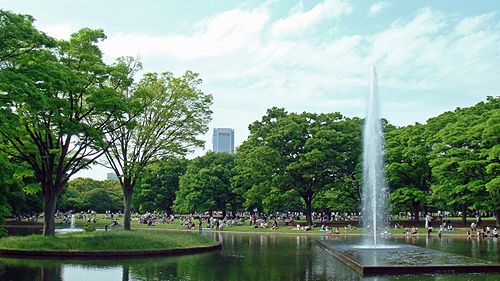| Yoyogi Park | |
|---|---|
 | |
 | |
| Location | Shibuya,Tokyo, Japan |
| Coordinates | 35°40′19″N139°41′52″E / 35.671975°N 139.69768536°E /35.671975; 139.69768536 |
| Area | 54.1 ha (134 acres) |
| Created | 1967 |
| Public transit access | Harajuku Station,Yoyogi-Koen Station,Meiji-jingumae Station |
Yoyogi Park (代々木公園,Yoyogi kōen) is a park inShibuya,Tokyo, Japan. It is located adjacent toHarajuku Station andMeiji Shrine inYoyogikamizonochō. The park is a popular Tokyo destination, especially on Sundays when it is used as a gathering place for Japanese rock music fans, jugglers, comedians,martial arts clubs,cosplayers and othersubculture and hobby groups.[1] In spring, thousands of people visit the park to enjoy thecherry blossom duringhanami. The landscaped park haspicnic areas, bike paths, cycle rentals, public sport courts, and a dog run.[2]
Yoyogi Park stands on the site from where the first successfulpowered aircraft flight in Japan took place by CaptainYoshitoshi Tokugawa on 19 December 1910.[3] The area later became an army parade ground. From September 1945, the site became a U.S. officers housing area known asWashington Heights during theAllied occupation of Japan.[4]
The area was used for the1964 Summer Olympics housing the mainOlympic village and theYoyogi National Gymnasium. The distinctive building, which was designed byKenzo Tange, hostedswimming anddiving, with an annex forbasketball.[5][6]
In 1967 most of the area north of the gymnasium complex and south ofMeiji Shrine was absorbed by Yoyogi Park.[1]
Tokyo's failed bid to host the2016 Summer Olympics included a proposal to redevelop Yoyogi Park. A new volleyball arena was to be built west of theYoyogi National Gymnasium. It would have replaced a small stadium with a football and athletics arena.[7] Yoyogi National Gymnasium later served as the venue forhandball events during the2020 Summer Olympics.[8]
In 2014, Tokyo experienced one of its worstdengue fever outbreaks in 100 years and the first recorded cases in 70 years, with nearly 200 confirmed cases.[9] The first case was reported on August 27, 2014. Using gene sequencing techniques, scientists determined that the outbreak originated in Yoyogi Park. Dozens of visitors to the area contracted the disease, leading to the park's closure on September 4.[9] No further cases were discovered after September 18, and the park re-opened to the public on October 31.[10]
 Media related toYoyogi Park at Wikimedia Commons
Media related toYoyogi Park at Wikimedia Commons